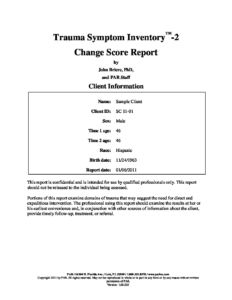
Trauma Symptom Inventory-2 tsi-2
For: Evaluate acute and chronic post-traumatic symptomatology
Reading Level: Ages 18 to 88 years
Format: Paper and pencil; Online administration and scoring via PARiConnect; or PC Based Software
Length: Administration 20 minutes, Scoring 20 minutes
Scoring: Hand Scored; PC Based Software; or online via PARiConnect
Online Forms, Reports, Kits & e-Manuals
All online resources including Forms, Reports, i-Admins, Kits and e-Manuals.
Printed Kits
Click to browse products
Printed Manuals
Physical printed manuals.
Printed Forms & Handscoring Materials
Test forms, response booklets and scoring reference manuals.
TSI-2 e-Manual
TSI-2/TSI-2-A online Score Report (each) min order 5
TSI-2/TSI-2-A online i-Admin (each) min order 5
TSI-2 Introductory Kit
TSI-2 Professional Manual
TSI-2 Hand Scorable Answer Sheets (25)
TSI-2 Profile Forms (25)
TSI-2 Reusable Item Booklets (10)
TSI-2-A Hand Scorable Answer Sheets (25)
TSI-2-A Profile Forms (25)
Author
John Briere, PhD
Description
The TSI-2 is designed to evaluate post-traumatic stress and other psychological sequelae of traumatic events. This broadband measure evaluates acute and chronic symptomatology, including the effects of sexual and physical assault, intimate partner violence, combat, torture, motor vehicle accidents, mass casualty events, medical trauma, traumatic losses, and childhood abuse or neglect.
The TSI-2 consists of 136 items and assesses a wide range of potentially complex symptomatology, ranging from post-traumatic stress disorder (PTSD), dissociation, and somatisation to insecure attachment styles, impaired self-capacities, and dysfunctional behaviours.
New in this Edition
Introduced in this edition are three new scales (Insecure Attachment, Somatic Preoccupations, and Suicidality) and two new sub-scales (Hyperarousal and Other-Directedness). The four TSI-2 summary factors are either new to this version or have been reconfigured based on newly added or modified scales.
New items were introduced to the TSI-2 validity scales in order to assess a client’s tendencies to deny symptoms that are commonly endorsed, to over-endorse unusual or bizarre symptoms, or to respond in an inconsistent or random manner. The Atypical Response validity scale was redesigned to assess not only over-reporting in general, but also potential misrepresentation of PTSD.
TSI-2-A
The alternate 126-item version of the form does not contain any sexual symptom items-the Sexual Disturbance scale (i.e., the Sexual Concerns and Dysfunctional Sexual Behaviour sub-scales) and the sexual symptom items associated with the Externalisation factor have been removed.
Eight critical items help you identify issues or behaviours that potentially represent severe psychological disturbance, danger to the respondent, or danger to others.
Reliable change scores are new to this edition of the measure and allow you to track progress and monitor change over time.
The validation sample consisted of five non-overlapping clinical groups: combat veterans, individuals with borderline personality disorder, sexual abuse victims, victims of domestic violence, and incarcerated women. A sample of subjects simulating PTSD was used to test malingering.
NB: Prices are in Australian dollars inclusive of GST. NZ customers need to log in to view ex-GST prices.
 NZ
NZ






